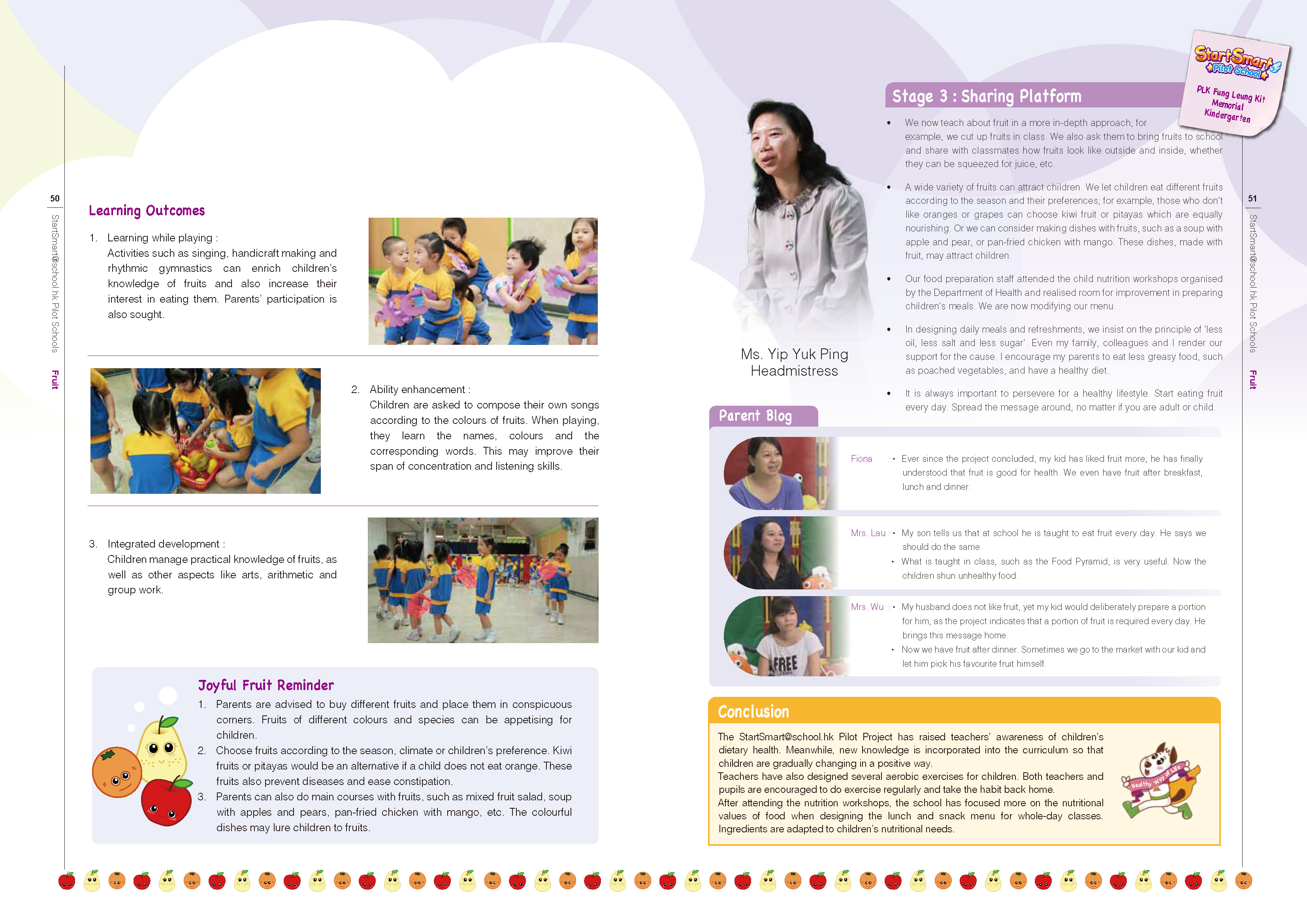
|
|
Learning Outcomes
- Learning while playing:
Activities such as singing, handicraft making and rhythmic gymnastics can enrich children’s knowledge of fruits and also increase their interest in eating them. Parents’ participation is also sought.
- Ability enhancement:
Children are asked to compose their own songs according to the colours of fruits. When playing, they learn the names, colours and the corresponding words. This may improve their span of concentration and listening skills.
- Integrated development:
Children manage practical knowledge of fruits, as well as other aspects like arts, arithmetic and group work.
Joyful Fruit Reminder
- Parents are advised to buy different fruits and place them in conspicuous corners. Fruits of different colours and species can be appetising for children.
- Choose fruits according to the season, climate or children’s preference. Kiwi fruits or pitayas would be an alternative if a child does not eat orange. These fruits also prevent diseases and ease constipation.
- Parents can also do main courses with fruits, such as mixed fruit salad, soup with apples and pears, pan-fried chicken with mango, etc. The colourful dishes may lure children to fruits.
Stage 3: Sharing Platform
Ms. Yip Yuk Ping , Headmistress
- We now teach about fruit in a more in-depth approach; for example, we cut up fruits in class. We also ask them to bring fruits to school and share with classmates how fruits look like outside and inside, whether they can be squeezed for juice, etc.
- A wide variety of fruits can attract children. We let children eat different fruits according to the season and their preferences; for example, those who don’t like oranges or grapes can choose kiwi fruit or pitayas which are equally nourishing. Or we can consider making dishes with fruits, such as a soup with apple and pear, or pan-fried chicken with mango. These dishes, made with fruit, may attract children.
- Our food preparation staff attended the child nutrition workshops organized by the Department of Health and realised room for improvement in preparing children’s meals. We are now modifying our menu.
- In designing daily meals and refreshments, we insist on the principle of ‘less oil, less salt and less sugar’. Even my family, colleagues and I render our support for the cause. I encourage my parents to eat less greasy food, such as poached vegetables, and have a healthy diet.
- It is always important to persevere for a healthy lifestyle. Start eating fruit every day. Spread the message around, no matter if you are adult or child.
Parent Blog
Fiona:
- Ever since the project concluded, my kid has liked fruit more; he has finally understood that fruit is good for health. We even have fruit after breakfast, lunch and dinner.
Mrs. Lau:
- My son tells us that at school he is taught to eat fruit every day. He says we should do the same.
- What is taught in class, such as the Food Pyramid, is very useful. Now the children shun unhealthy food.
Mrs. Wu:
- My husband does not like fruit, yet my kid would deliberately prepare a portion for him, as the project indicates that a portion of fruit is required every day. He brings this message home.
- Now we have fruit after dinner. Sometimes we go to the market with our kid and let him pick his favourite fruit himself.
Conclusion
The StartSmart@school.hk Pilot Project has raised teachers’ awareness of children’s dietary health. Meanwhile, new knowledge is incorporated into the curriculum so that children are gradually changing in a positive way.
Teachers have also designed several aerobic exercises for children. Both teachers and pupils are encouraged to do exercise regularly and take the habit back home.
After attending the nutrition workshops, the school has focused more on the nutritional values of food when designing the lunch and snack menu for whole-day classes.Ingredients are adapted to children’s nutritional needs.
|